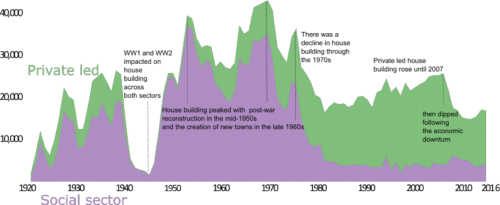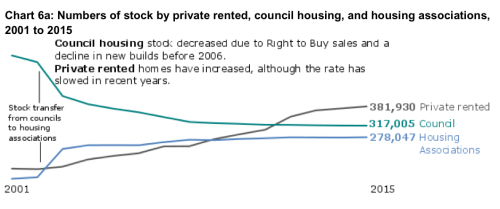The Broken Housing Market Conference, London
The Institute for Civil Engineering in Westminster hosted a one-day housing conference – ‘the broken housing market’ on June 1, 2018. The conference was organised by RICS, NIESR and CaCHE. The conference had a starry array of speakers, including David Miles, Ian Mulheirn, Kate Barker, Steven Aldridge, Paul Cheshire, Christine Whitehead and John Muellbauer, among others. I was asked to provide closing remarks which meant I had to stay honest and really concentrate throughout the four sessions, 13 speakers and discussion sessions. Short videos from several speakers can be found here.
The event was named after last year’s white paper – Fixing our Broken Housing Market – and covered different dimensions of what is conceivably wrong with housing and what needs to be done to address such shortcomings. It is important to state from the outset that different views were forcefully expressed about these problems e.g. whether they were ostensibly on the supply-side or demand side (or indeed both) or indeed were mainly about policy failure. Some of these differences reflected disciplinary or background factors but also in some cases concerned different approaches to housing economics as a sub-discipline.
The structure of the conference was in four parts. The first session was entitled housing and consumption and dealt with many of the familiar housing and macroeconomy questions – how does rising house prices feed into consumption and additional mortgage re-leverage; what role does housing collateral play; how has the UK market been changed by mortgage stress tests, lower LTVs and the macro-prudential policy context. The second session was ostensibly about affordability though it somewhat morphed into a much more fundamental discussion of how one views housing as either a consumption good or as an asset. After lunch Kate Barker reprised the housing supply question 14 years on from the review of housing supply. Stephen Aldridge provided a substantial reply. The final session involved four policy papers aiming different cases for reform and one which raised wider questions about what we actually mean by housing policy.
The main things that struck me today were the following:
- There is a lively debate between mainstream housing economists about what is going on in the housing market, how it fits together and what needs to be done.
- Mulheirn argued that the housing problem is primarily an asset issue, not a housing services question (in many places housing consumption costs are reasonable and stable). He also argued that the problem is much more a demand than a supply shortage issue. This was not accepted by many in the room who remain wedded to the need for more supply.
- There was much discussion of housing tax reform but it was strongly encouraged that promoters of housing/land tax reform invest in good policy design and careful, cautious implementation.
- Ian Mulheirn also spoke about a policy trilemma i.e. that it is possible to have one or even two but not three policy objectives simultaneously – where those objectives are financial stability, home ownership growth and pro-owner fiscal policies.
- We are still arguing about the definition of affordability but linked to this the assumptions set out in banker affordability stress tests are highly sensitive and contested i.e. they seem much more conservative than most credible independent forecasts of inflation and interest rates.
- David Miles sketched out a model that might help explain the future long-term trajectory of real house prices and argued because of the sensitivities of two key elasticities (between land and structures) and between housing and non-housing consumption, it was very difficult to confidently work out the fundamental real house price – and this matters materially for macro prudential policy if one is to have a benchmark from which to assess how far away prices are from a fundamental equilibrium. As an aside, he also argued that the tax relief reductions on private renting landlords were ill thought through.
- Christine Whitehead distinguished her interest on policy details from the grand design others had for housing and policy reform (even though she agreed with the aims). Her point was that housing policy has different governmental masters (MHCLG, DWP, Treasury, the Bank, etc), a plethora of different stakeholders and an alarming tendency to generate new policy instruments; yet little clarity on what the housing policy was really for or about – and more to the point in her view, it has always been much like this.
I particularly liked the eight stylised housing facts (i.e. that we should all agree with and take as our starting point) as laid out by Stephen Aldridge. These were:
- Affordability pressures exist, particularly in London and the south east
- There has been a 50% rise in the number of concealed households (alongside many more young people staying with parents)
- Most young people who don’t currently, still want to own their own home
- A shortage of housing supply is indicated
- We can build more homes
- We are building more homes than in recent previous years.
- A sustained substantial increase in housing supply is required to impact on affordability
- There is plenty of land in the right places for additional housing supply.
In my wrap-up, I tried to set out how CaCHE might play an ongoing role in this area. Kate Barker had indicated in her talk that the new centre was a rare opportunity to provide evidence and build conceptually. We certainly want to do just that. I also made the point that the private rented market is a complex mosaic of well-defined and largely independent segments on either side of the market. This is neither well evidenced nor conceptually understood sufficiently to allow us to have confidence that policy-makers reflect the sector’s subtleties. This led to my final comment, arising from the on-going policy transfer exemplar project we are undertaking, that we do not as housing researchers make anything like the full use of the policy studies or policy analysis literature i.e. the models that might shed light on the policy process in housing. We need to change that fact as we move on to our more empirical research.


